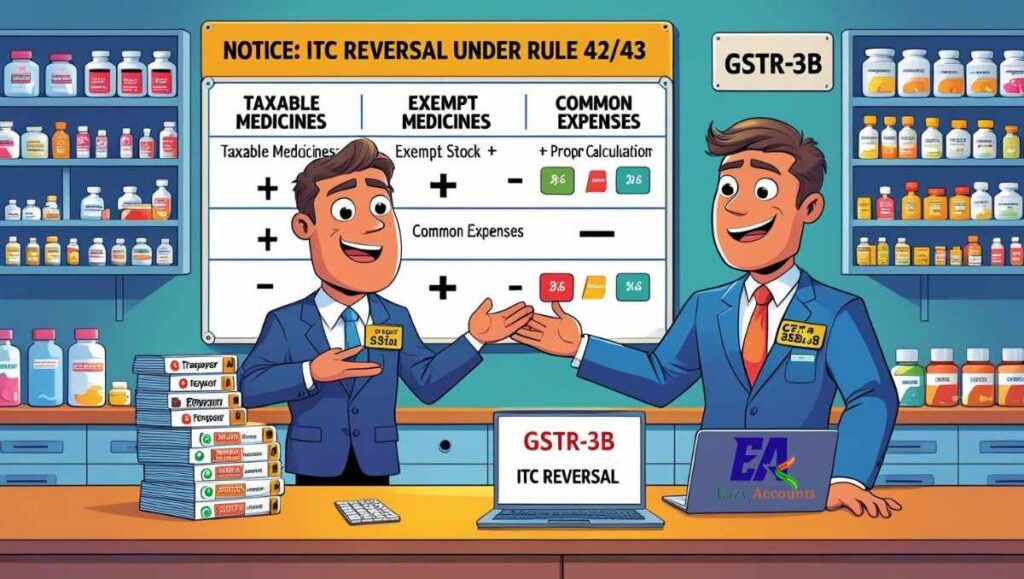Have you received a notice from the GST Department asking for ITC Reversal for Exempt Supplies?
“Reverse Input Tax Credit in proportion to exempt supplies under Rule 42 or Rule 43…”
You’re not alone — this kind of notice is landing in inboxes across industries.
And no, it’s not limited to big financial institutions or health and education businesses.
Even small and medium businesses — selling both taxable and exempt goods or services (like medicine, vegetables, or catering + raw grains) — are being flagged.
The moment the department sees a mix of taxable and exempt supplies, it expects you to apply Rule 42 and Rule 43 of the CGST Rules, and reverse a portion of your Input Tax Credit (ITC).
But why this reversal?
You’ve paid GST on your purchases — so why do you have to give some of it back?
Let’s break it down — clearly, quickly, and with just enough sarcasm to make tax a little less boring.

Let’s get one thing straight — Input Tax Credit (ITC) is not your birthright. It’s a benefit, but a conditional one.
The GST law gives you the credit of taxes paid on your purchases only if those purchases are used for making taxable or zero-rated supplies.
Now here’s the twist:
If some of your purchases are being used to make exempt supplies, the government says:
“Why should we give you ITC if you’re not charging GST on the output?”
Fair point, right?
So, when your business deals with both taxable and exempt supplies, the law expects you to:
- Segregate the purchases used for exempt activities, and
- Reverse the proportionate ITC on those purchases.
This is where Rule 42 (for inputs/input services) and Rule 43 (for capital goods) come in.
Think of them as the math teachers of GST — here to calculate what part of your ITC you can keep, and what part you must give up.
In short:
If your ITC is partly related to exempt supplies, you can’t claim 100% of it.
Rule 42 and 43 provide a step-by-step formula to proportionately reverse ITC based on the ratio of exempt to total turnover.
When Inputs Are Taxable but Outputs Are Not!
You might wonder — “Why should I reverse ITC? I paid GST on my purchases!”
True. But what if your sales are exempt?
Here are some real-world situations where this happens:
- A grocery store buys packaging material (taxable) but sells unbranded vegetables (exempt)
- A hospital buys medical equipment (taxable) but offers healthcare services (mostly exempt)
- A caterer provides both taxable catering and exempt food distribution for NGOs
- An education institute pays GST on rent and ads, but tuition fees are exempt
In all these cases:
- You paid GST on inputs, but
- You didn’t collect GST on output
Hence, the law steps in and says: “If you’re not charging GST from your customers, don’t enjoy full ITC either.”
First Things First: Keep Your ITC Records Clear
Before we talk formulas and rules — let’s understand when you actually need to reverse ITC.
In India, most businesses don’t deal with just one kind of product. A typical trader or shopkeeper may sell:
- Taxable items (like cold drinks, packed snacks)
- Exempt items (like unbranded atta, fresh fruits or vegetables)
Now the real catch:
Most exempt items are also bought without GST
So, if you didn’t pay GST while buying, there’s no ITC claimed, and no need to reverse.
Then When Does ITC Reversal for Exempt Supplies Come In?
Only when this happens:
You bought something with GST, and used it to sell goods or services that are exempt.
Examples:
- You rent a shop (GST paid on rent), and sell both biscuits (taxable) and fruits (exempt)
- You buy a billing printer (with GST) but use it for all sales, taxable and exempt
These are common expenses — and that’s where Rule 42/43 kicks in.
How to Keep Things Sorted (3 Simple Buckets)
| Type of Purchase | Used For | What to Do With ITC |
|---|---|---|
| Bought with GST, used only for taxable sales | Like packaging for chips | Full ITC allowed |
| Bought with GST, used only for exempt sales | Like bags for fruits | ITC not allowed |
| Bought with GST, used for both | Like shop rent, electricity, ads | Reverse proportionally under Rule 42/43 |
This third type is what we call common credit.
You don’t lose it all — just reverse the part used for exempt supplies.
ITC Reversal for Exempt Supply at a Glance — Rule 42 vs Rule 43
| Particulars | Rule 42 (Inputs & Input Services) | Rule 43 (Capital Goods) |
|---|---|---|
| Applicable On | Inputs and input services | Capital goods (machinery, equipment, etc.) |
| Type of Credit | Common ITC (used for both exempt & taxable) | Common ITC on capital goods |
| Reversal Frequency | Monthly + Annual Adjustment | Monthly spread over 60 months |
| Formula | (Exempt Turnover ÷ Total Turnover) × Common ITC | Proportionate reversal: same logic but over 60 months |
| Purpose | To reverse ITC linked to exempt output | To reverse capital goods ITC used commonly |
| Adjustment at Year-End? | Yes, based on actual turnover | Yes, for actual usage pattern |
Example – Rule 42: Inputs
Let’s say:
- Total ITC on inputs/services = ₹1,00,000
- Out of which, ₹40,000 is common ITC
- Exempt Turnover = ₹20 lakhs
- Total Turnover = ₹1 crore
Reversal = (20L ÷ 1Cr) × ₹40,000 = ₹8,000
✅ You can claim ₹92,000
❌ You must reverse ₹8,000 (added to output tax)
Example – Rule 43: Capital Goods
Let’s say:
- You bought a machine for ₹6,00,000 + ₹1,08,000 GST
- It’s used for both taxable and exempt services
- Useful life for GST = 60 months
- Exempt Turnover = ₹30 lakhs
- Total Turnover = ₹1 crore
Monthly ITC = ₹1,08,000 ÷ 60 = ₹1,800
Now apply proportion:
Reversal = (30L ÷ 1Cr) × ₹1,800 = ₹540/month
This ₹540 needs to be added to output tax each month for 60 months
(And re-calculated if usage changes!)
What You Should Do (Before GST Dept Asks)
Here’s what every smart taxpayer should start doing:
- Keep separate records for taxable and exempt purchases
- Identify common expenses and mark them clearly in your books
- Do the reversal calculation at the end of each month (or at least quarterly)
- Adjust the reversal in GSTR-3B under ITC Reversal column
- Keep working notes ready — in case the officer asks, you have a clean trail
Remember, GST reversal isn’t a penalty — it’s a logical adjustment.
But if you ignore it, then yes… you may get a demand with interest and penalty.
And that’s not so logical anymore, is it?
Need Help Figuring This Out?
Don’t worry — you’re not alone! If you’ve received a notice or are unsure about how to maintain your taxable and exempt records properly, we’re here to help. Whether it’s ITC reversal under Rule 42/43, GST return cleanup, or just understanding what the law expects from your business — our team can guide you step-by-step, without the jargon.
Reach out today and stay compliant — the smart way!
